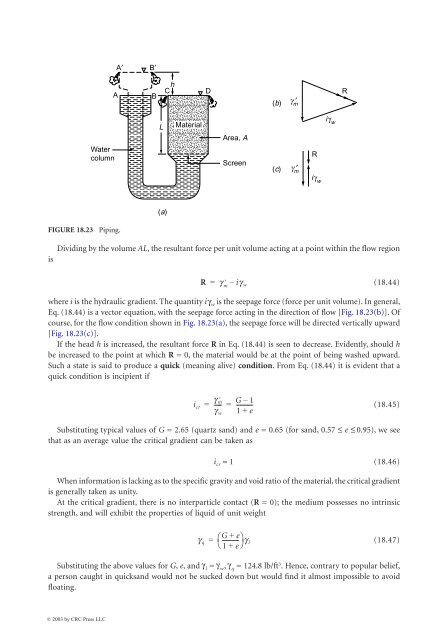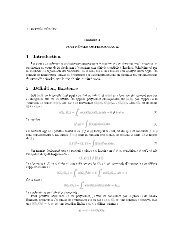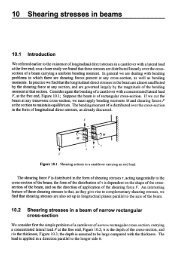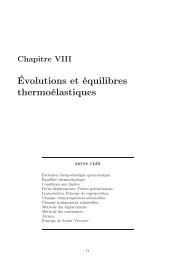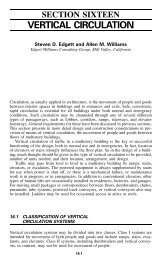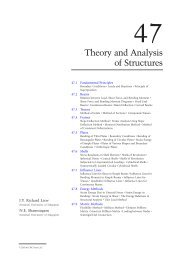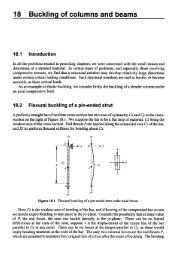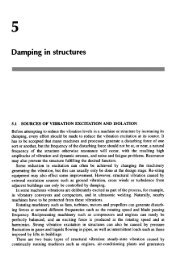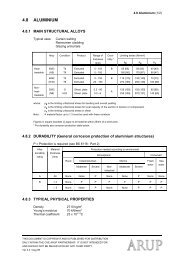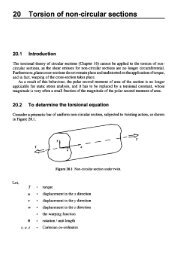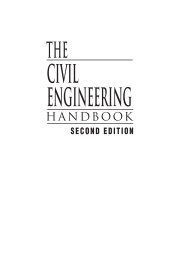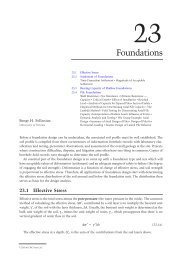Chapter 18: Groundwater and Seepage - Free
Chapter 18: Groundwater and Seepage - Free
Chapter 18: Groundwater and Seepage - Free
You also want an ePaper? Increase the reach of your titles
YUMPU automatically turns print PDFs into web optimized ePapers that Google loves.
<strong>Groundwater</strong> <strong>and</strong> <strong>Seepage</strong> <strong>18</strong>-23A′ B′ABC hD(b)g m ′RWatercolumnLMaterialArea, AScreen(c)g m ′Riγ wiγ w(a)FIGURE <strong>18</strong>.23 Piping.isDividing by the volume AL, the resultant force per unit volume acting at a point within the flow regionR = g ¢ m– ig w(<strong>18</strong>.44)where i is the hydraulic gradient. The quantity i g w is the seepage force (force per unit volume). In general,Eq. (<strong>18</strong>.44) is a vector equation, with the seepage force acting in the direction of flow [Fig. <strong>18</strong>.23(b)]. Ofcourse, for the flow condition shown in Fig. <strong>18</strong>.23(a), the seepage force will be directed vertically upward[Fig. <strong>18</strong>.23(c)].If the head h is increased, the resultant force R in Eq. (<strong>18</strong>.44) is seen to decrease. Evidently, should hbe increased to the point at which R = 0, the material would be at the point of being washed upward.Such a state is said to produce a quick (meaning alive) condition. From Eq. (<strong>18</strong>.44) it is evident that aquick condition is incipient ifgi m¢cr = ----- =g wG – 1------------1 + e(<strong>18</strong>.45)Substituting typical values of G = 2.65 (quartz s<strong>and</strong>) <strong>and</strong> e = 0.65 (for s<strong>and</strong>, 0.57 £ e £ 0.95), we seethat as an average value the critical gradient can be taken asi cr ª 1(<strong>18</strong>.46)When information is lacking as to the specific gravity <strong>and</strong> void ratio of the material, the critical gradientis generally taken as unity.At the critical gradient, there is no interparticle contact (R = 0); the medium possesses no intrinsicstrength, <strong>and</strong> will exhibit the properties of liquid of unit weightG+eg q = Ê------------ˆ gË1 + e ¯ l(<strong>18</strong>.47)Substituting the above values for G, e, <strong>and</strong> g l = g w , g q = 124.8 lb/ft 3 . Hence, contrary to popular belief,a person caught in quicks<strong>and</strong> would not be sucked down but would find it almost impossible to avoidfloating.© 2003 by CRC Press LLC


